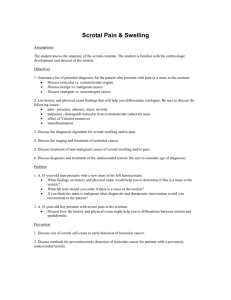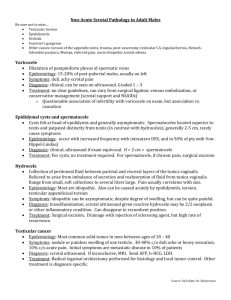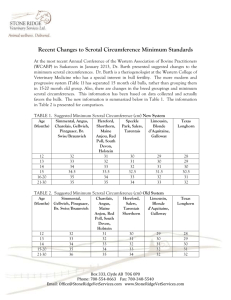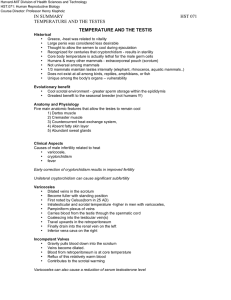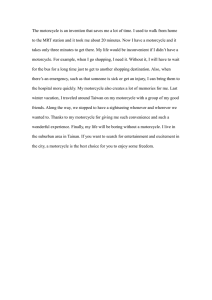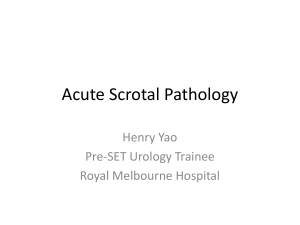CASE REPORT SCROTAL / TESTICULAR TRAUMA IN MOTORCYCLE ACCIDENTS
advertisement
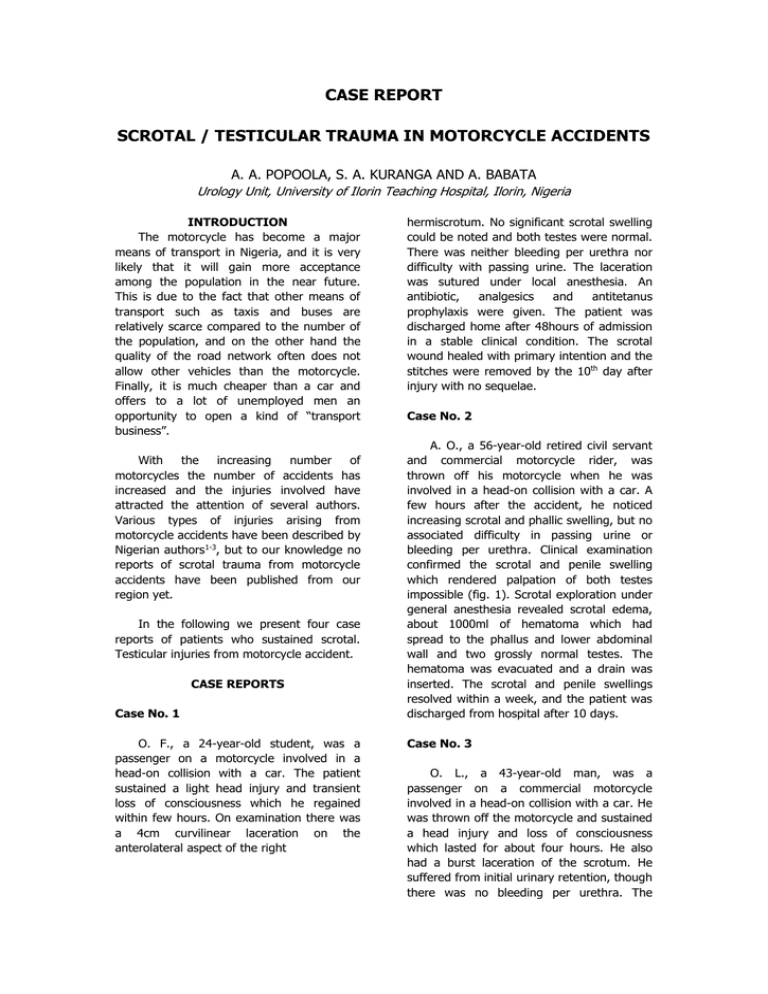
CASE REPORT SCROTAL / TESTICULAR TRAUMA IN MOTORCYCLE ACCIDENTS A. A. POPOOLA, S. A. KURANGA AND A. BABATA Urology Unit, University of Ilorin Teaching Hospital, Ilorin, Nigeria INTRODUCTION The motorcycle has become a major means of transport in Nigeria, and it is very likely that it will gain more acceptance among the population in the near future. This is due to the fact that other means of transport such as taxis and buses are relatively scarce compared to the number of the population, and on the other hand the quality of the road network often does not allow other vehicles than the motorcycle. Finally, it is much cheaper than a car and offers to a lot of unemployed men an opportunity to open a kind of “transport business”. With the increasing number of motorcycles the number of accidents has increased and the injuries involved have attracted the attention of several authors. Various types of injuries arising from motorcycle accidents have been described by Nigerian authors1-3, but to our knowledge no reports of scrotal trauma from motorcycle accidents have been published from our region yet. In the following we present four case reports of patients who sustained scrotal. Testicular injuries from motorcycle accident. CASE REPORTS Case No. 1 O. F., a 24-year-old student, was a passenger on a motorcycle involved in a head-on collision with a car. The patient sustained a light head injury and transient loss of consciousness which he regained within few hours. On examination there was a 4cm curvilinear laceration on the anterolateral aspect of the right hermiscrotum. No significant scrotal swelling could be noted and both testes were normal. There was neither bleeding per urethra nor difficulty with passing urine. The laceration was sutured under local anesthesia. An antibiotic, analgesics and antitetanus prophylaxis were given. The patient was discharged home after 48hours of admission in a stable clinical condition. The scrotal wound healed with primary intention and the stitches were removed by the 10th day after injury with no sequelae. Case No. 2 A. O., a 56-year-old retired civil servant and commercial motorcycle rider, was thrown off his motorcycle when he was involved in a head-on collision with a car. A few hours after the accident, he noticed increasing scrotal and phallic swelling, but no associated difficulty in passing urine or bleeding per urethra. Clinical examination confirmed the scrotal and penile swelling which rendered palpation of both testes impossible (fig. 1). Scrotal exploration under general anesthesia revealed scrotal edema, about 1000ml of hematoma which had spread to the phallus and lower abdominal wall and two grossly normal testes. The hematoma was evacuated and a drain was inserted. The scrotal and penile swellings resolved within a week, and the patient was discharged from hospital after 10 days. Case No. 3 O. L., a 43-year-old man, was a passenger on a commercial motorcycle involved in a head-on collision with a car. He was thrown off the motorcycle and sustained a head injury and loss of consciousness which lasted for about four hours. He also had a burst laceration of the scrotum. He suffered from initial urinary retention, though there was no bleeding per urethra. The patient voided clear urine while being prepared for scrotal exploration and suprapubic cystostomy. Exploration revealed a 10cm scrotal laceration and a hematoma in the scrotum. The left testis was shattered, while the right testis was normal. The shattered testis was excised, the hematoma evacuated, a drain was placed in the scrotum and the laceration sutured. The patient was given an antibiotic, analgesic and antitetanus prophylaxis. He was discharged from hospital after about two weeks with a normal neurological status and a healed scrotal wound. motorcycle halts as a result of applying the brake suddenly, or when it collides with another vehicle or an object, either the rider or the passenger may be thrown forward and the Case No. 4 O. O., a 40-year-old commercial motorcycle rider, was involved in a road accident and was brought to the hospital immediately. The patient sustained a head injury, transient loss of consciousness and also a scrotal laceration. He regained consciousness as soon as he got to the hospital. The scrotal laceration was about 10cm long, while both testes were intact. The laceration was sutured and the wound healed by primary intention. The patient was given an antibiotic, analgesic and antitetanus prophylaxis and he was discharged from hospital after about 10days. DISCUSSION Urogenital injuries are uncommon4. The scrotum / testes are among the least commonly injured urogenital organs5. This unvulnerability may be a result of the location of these organs between the thighs where they are well protected. However, in a sitting position on a motorcycle, the scrotum lies in front of the individual with the thighs widely apart which renders the scrotum vulnerable. Injuries to the scrotum may be sustained when the motorcycle enters a ditch and the passenger or rider is thrown upwards. The scrotum may then be squeezed between the seat and the perineum as the individual returns to the seat. This may result in crushing of the scrotum with intrascrotal hematoma, burst laceration of the scrotum or testicular rupture. A deceleration may occur when the Fig. 1: Scrotal hematoma extending to the penis following a motorcycle accident. Handle bar of the motorcycle may cause blunt trauma to the abdomen and perineum, including the scrotum6. This trauma may result in varying degrees on injury to the scrotum and testes. Penetrating injuries are also possible when parts of the motorcycle penetrate the scrotum. The type or degree of injury sustained by our patients no. 2, 3 and 4 suggests that they must have been exposed to a significant amount of force. However, none of our patients had associated long bone fractures, although these were the commonest type of injury reported by Oluwadiya et al2. From Osogbo south-western Nigeria. In his series of 145 victims of motorcycle accidents 115 (79.3%) had limb injuries. Like all other injuries arising from accidents, scrotal / testicular trauma usually does not occur in isolation. Associated injuries which are often life-threatening may demand priority attention which may lead to neglect of possible scrotal / testicular trauma such as testicular dislocation or a swollen scrotum with shattered testes as in case 3 of this report. However, urogenital injury, if not promptly and adequately treated, may lead to adverse effects on reproduction. Fournier et al7. reported that the likelihood of testicular salvages is approximately 90% if surgery is done within 72 hours but drops to 48% if surgery is performed after this period. Therefore, proper examination of victims of motorcycle accidents should always include the external genitalia to ensure their salvage if necessary8. Not all patients with scrotal trauma need exploration. If the testes are easily palpable, even in the presence of hematoma, these cases can often be treated conservatively. Difficulty in palpating the testes following trauma suggests the presence of a hematocele which should be explored and drained. Then the testis should be repaired or excised as necessary. Though scrotal ultrasonography was not applied in the management of any of our cases, it is an important tool in making an adequate diagnosis to decide on the proper management9. Brown and Dinchman10 found no specific symptoms or signs that differentiated testicular rupture from other scrotal emergencies and stressed the importance of clinical correlations. We conclude that scrotal / testicular injury is not common in daily urological practice. However, it should always be borne in mind that it may coexist with other organ injuries caused by traffic or other accidents. Delayed treatment of testicular injury may affect the fertility of the patient. This emphasizes the need for a thorough scrotal examination, especially in traumatized patients from motorcycle accidents. REFERENCES 1. Odelowo E.O. Patterns of trauma resulting from motorcycle accidents in Nigeria: a two year prospective study. Afr. I Med Sci 1994, 23:109. 2. Oluwadiya K.S., Oginni LM, Olasinde AA, Fadiora SO. Motorcycle limb injuries in a developing country. West Afr. J Med 2004, 23:42 3. Adegbehingbe B.O. Oluwadiya KS. Adegbehinge O.O. Motorcycle associated ocular injuries in Ile-Ife Nigeria. Afr. J Trauma 2004, 2:35. 4. Mbibu NH, Khalid L. Maitama HY et al. The pattern of urogenital trauma in ABUTH, Zaria, Nigeria. 10 years study. Nigeria Journal of Surgical Research 1999, 1:25. 5. Popoola AA. Pattern of urogenital injuries at the University College Hospital, Ibadan, between July 2001 and June 2002. A dissertation submitted to the National Postgraduate Medical College of Nigeria for the award of a fellowship in surgery. November 2003 6. Shioni H, Hase T, Matsuno S et al. Handle bar hernia with intra-abdominal extraluminal air presenting as a novel form of traumatic abdominal wall hernia: Report of a case. Surg Today 1999. 29:1280. 7. Fournier GR Jr. Laing FC, McAninch JW. Scrotal ultrasonography and the management of testicular trauma. Urol North Am 1989. 16:377. 8. Gross M. Rupture of the testicle: the importance of early surgical treatment. J Urol 1969, 101:196. 9. Ko SF, Ng SH, Wan YL et al. Testicular dislocation: an uncommon and easily overlooked complication of blunt abdominal trauma. Ann Emerg Med 2004, 43:371. 10. Brown SL, Dinchman KH. Testicular trauma. Atlas Urol Clin North Am 1998, 6:119.
